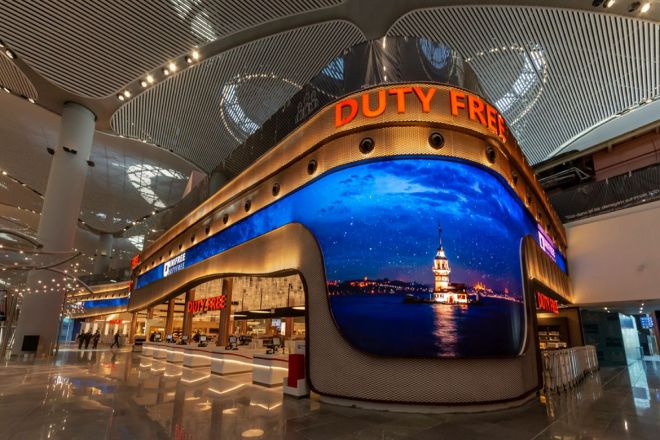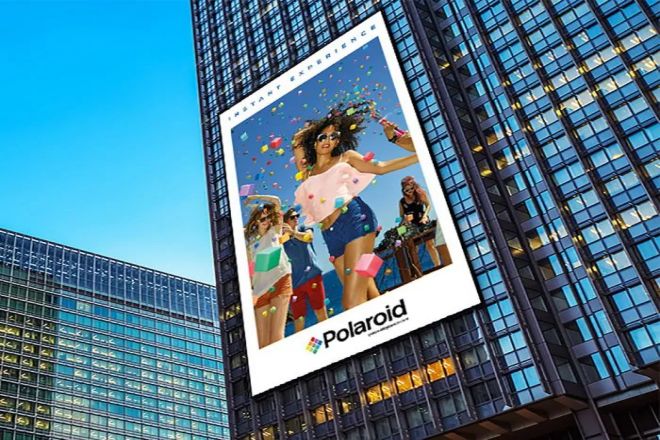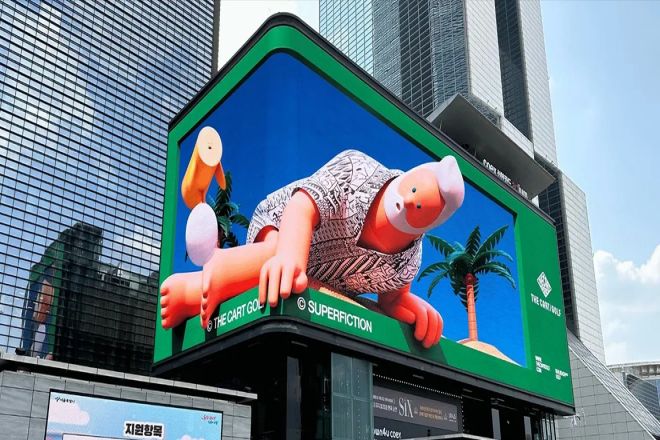Introducción

La fuente del video de Pantalla LED, como su fuerza impulsora principal, no solo transmite información, sino que también es el punto de partida del espectáculo visual. Su calidad determina directamente la claridad de la imagen en la pantalla, la intensidad del color y la transmisión precisa de la información.
Para la pantalla LED 3D de última generación, la fuente de video 3D es un alma indispensable, que le da a la imagen profundidad y capas, permitiendo al público disfrutar de una experiencia visual tridimensional inmersiva sin equipo auxiliar.
Esta integración de tecnología no solo requiere que la fuente de video tenga un alto grado de realismo y gran riqueza de detalles, sino que también pone a prueba la excelente capacidad de la pantalla en el procesamiento de imágenes, la restauración del color y la presentación de efectos tridimensionales y, en conjunto, promueve el arte visual a un nuevo nivel.
1. Color y brillo de las fuentes de vídeo de las pantallas LED
Ya has explicado bien los puntos clave respecto a los requisitos de color y brillo de las fuentes de vídeo de las pantallas LED.
Aquí perfeccionaré y complementaré más información relevante para comprender más plenamente la importancia de estos requisitos y cómo lograrlos.
1) Requisitos de color
1.1) Alta saturación y contraste.
- Alta saturación:
Una alta saturación significa que los colores son más brillantes y vívidos y pueden mostrar con mayor precisión los detalles y los niveles de color del contenido de video.
Los píxeles de las pantallas LED pueden emitir una luz de color relativamente pura, por lo que la rica información de color en la fuente de video se puede convertir directamente en impresionantes efectos visuales en la pantalla.
- Alto contraste:
Las fuentes de video con alto contraste pueden distinguir claramente entre las partes brillantes y oscuras de la imagen, lo que hace que la imagen sea más tridimensional y con más capas. En el caso de las pantallas LED, el alto contraste no solo mejora el impacto visual, sino que también ayuda a mantener la claridad de la imagen cuando se ve a distancia.
1.2) Recomendación de fondo negro (especialmente para pantallas LED transparentes)
- Utilización transparente de funciones:
Las pantallas LED transparentes pueden integrarse en el entorno y crear un efecto visual único gracias a su exclusivo diseño de panel posterior transparente. Los fondos negros no solo pueden mejorar visualmente esta sensación de integración, sino que también reducen el consumo de energía al reducir la transmisión de luz.
- Mayor sentido de jerarquía:
El fuerte contraste entre el fondo negro y el contenido brillante puede formar una capa visualmente distinta y atraer la atención del público. Este diseño es especialmente adecuado para ocasiones en las que se necesita destacar información específica o crear una atmósfera específica.
2). Brillo ajuste
2.1) Adaptarse a la luz ambiental
- Ajustar automáticamente el brillo:
Las pantallas LED modernas suelen estar equipadas con sensores de brillo y sistemas de control inteligentes que pueden ajustar automáticamente el brillo de la pantalla según los cambios en la luz ambiental. Esta función de ajuste automático garantiza que los espectadores puedan obtener la mejor experiencia de visualización en diferentes condiciones de iluminación.
- Opción de ajuste manual:
Además del ajuste automático, muchas pantallas LED también ofrecen la opción de ajustar manualmente el brillo para que los usuarios puedan realizar ajustes precisos según las necesidades reales. El ajuste manual se suele lograr a través del software de control de la pantalla o del control remoto, que es fácil y rápido de operar.
2.2) Importancia del ajuste del brillo
- Ahorro de energía y reducción del consumo:
Reducir adecuadamente el brillo de la pantalla en un entorno poco iluminado no solo puede reducir el consumo de energía sino también extender la vida útil de la pantalla LED.
- Proteger la vista:
El brillo excesivo puede tener efectos adversos en la vista de los espectadores. Un ajuste razonable del brillo ayuda a proteger la salud visual de los espectadores.
- Mejorar la experiencia de visualización:
Ya sea en entornos exteriores o interiores, mantener la imagen clara y visible a través del ajuste del brillo es uno de los factores clave para mejorar la experiencia visual de la audiencia.
2. Resolución y claridad de la fuente de vídeo de la pantalla LED

1). Resolución y claridad de la fuente de video de la pantalla LED
- Estándar HD
Con el desarrollo continuo de la tecnología de pantalla digital, la pantalla de alta definición se ha convertido en un requisito básico.
Para pantallas LED de uso general, como anuncios comerciales, eventos deportivos en vivo, comunicados de información pública, etc., la resolución de la fuente de video debe ser al menos 1920*1080 (también conocida como Full HD o 2K).
Este estándar de resolución garantiza que el contenido de video se presente en la pantalla con una calidad de imagen nítida para satisfacer las necesidades de visualización de la mayoría de los espectadores.
- Requisitos de alta resolución
Sin embargo, en situaciones donde se busca una mayor calidad de imagen y efectos visuales más delicados, como grandes centros de comando y despacho, sistemas de visualización de big data o entornos de reproducción profesional de películas y televisión, los requisitos de resolución de la fuente de video son mayores.
En estos casos, la resolución de la fuente de video debe alcanzar 3840*2160 (4K) o superior (como 8K). Las fuentes de video de alta resolución pueden mostrar más detalles, hacer que la imagen sea más delicada y realista y brindar una experiencia de visualización inmersiva a la audiencia.
Especialmente cuando se implementa una visualización punto a punto, es decir, cada píxel LED corresponde a un píxel en la fuente de video, lo que puede minimizar el desenfoque y la irregularidad de la imagen y mejorar la calidad general de la visualización.
2) Coincidencia de relación de aspecto
- Consistencia
La relación de aspecto de la fuente de vídeo se refiere a la relación entre el ancho y la altura de la imagen de vídeo. Para garantizar que la imagen de vídeo reproducida en la pantalla LED no se deforme ni se distorsione, la relación de aspecto de la fuente de vídeo debe ser exactamente la misma que la de la pantalla LED.
Esta coherencia es un requisito previo importante para garantizar la calidad de la imagen y la experiencia del público. Si la relación de aspecto de la fuente de vídeo no coincide con la pantalla, la imagen se estirará o se comprimirá, lo que afectará el efecto de visualización.
- Ajuste flexible
Sin embargo, en aplicaciones reales, las formas y proporciones de las pantallas LED pueden variar, como por ejemplo, en arco, en forma de L, en forma especial, etc.
Para satisfacer las necesidades de estas pantallas con formas especiales, la fuente de video debe tener la capacidad de ajustarse de manera flexible. Esto generalmente se logra mediante software de procesamiento de video o dispositivos de hardware, que pueden ajustar o recortar la relación de aspecto de la fuente de video para adaptarse a pantallas LED de diferentes formas y proporciones.
Al mismo tiempo, algunos sistemas de procesamiento de video avanzados también admiten la tecnología de deformación de imágenes en tiempo real, que puede mapear perfectamente el contenido de video a la pantalla de forma especial sin perder demasiada calidad de imagen.
3. Formato de vídeo y codificación de la fuente de vídeo de la pantalla LED
1) Compatibilidad de formatos de vídeo
Cuando queremos reproducir un vídeo en una pantalla LED, primero debemos asegurarnos de que el formato del archivo de vídeo sea “comprensible” para la pantalla. Al igual que cuando vemos películas en teléfonos móviles, necesitamos que el archivo de la película esté en un formato compatible con el teléfono móvil.
Los formatos de video comunes para pantallas LED incluyen AVI y MP4, que son como el “mandarín” en la industria del video, y la mayoría de las pantallas pueden reconocerlos y reproducirlos fácilmente.
2) Estándar de codificación de vídeo
La codificación de video es como aplicar una “capa de compresión” al contenido de video, haciendo que el archivo de video sea más pequeño, más fácil de transmitir y almacenar, mientras se intenta mantener intacta la calidad de la imagen.
H.264 y H.265 son dos estándares de codificación de video muy populares que pueden hacer que los archivos de video sean más delgados y al mismo tiempo mantener una calidad de imagen nítida.
Las pantallas LED deben poder “desbloquear” estos códigos y mostrar el contenido de video.
3) Capacidad de decodificación
Hay un “decodificador” dentro de la pantalla LED, y su función es “traducir” el archivo de vídeo codificado a la imagen que podemos ver.
Este decodificador debe ser lo suficientemente potente para procesar con rapidez y precisión varios formatos de video y estándares de codificación para garantizar que el video no se trabe durante la reproducción y que la imagen sea fluida y clara.
En pocas palabras, al igual que cuando vemos una película en un idioma extranjero, necesitamos un grupo de subtítulos para traducir la película al chino para que podamos entenderla.
El decodificador de la pantalla LED es el “grupo de subtítulos”, que es responsable de traducir el archivo de vídeo en la imagen que la pantalla puede mostrar.
Por lo tanto, cuando elegimos una fuente de video para reproducir en la pantalla LED, debemos prestar atención a si el formato de video es compatible, si el estándar de codificación es eficiente y si la capacidad de decodificación de la pantalla es lo suficientemente fuerte.
De esta manera, podemos garantizar que el contenido de vídeo presente el mejor efecto en la pantalla LED.
4. Requisitos especiales para fuentes de vídeo de pantallas LED 3D

1) Producción personalizada
- Planificación de efectos 3D
En el caso de las pantallas LED 3D, la producción personalizada de fuentes de vídeo es fundamental. Esto implica algo más que una simple edición de vídeo, ya que requiere una planificación detallada de los efectos 3D.
La etapa de planificación debe considerar cómo crear una fuerte sensación de tridimensionalidad e impacto visual a través del contenido de video para que la audiencia pueda sentir el efecto impactante del 3D a simple vista sin usar ningún equipo.
Esto generalmente incluye el diseño de elementos como profundidad, capas y cambios dinámicos en el video para garantizar que el efecto 3D final sea realista y fascinante.
- Alta resolución y gran tamaño.
Para mejorar aún más la claridad y la inmersión del efecto 3D, se recomienda utilizar pantallas LED de alta resolución (como 4K o superior) y de gran tamaño tanto como sea posible.
La alta resolución garantiza que cada detalle del vídeo se pueda mostrar claramente, mientras que el gran tamaño permite que la audiencia esté más inmersa en el mundo 3D como si estuviera en la escena del vídeo.
Esta combinación puede mejorar significativamente la experiencia visual de la audiencia y hacer que el efecto 3D sea más realista e impactante.
2) Optimización de la experiencia de visualización
La distancia y el ángulo de visualización tienen un impacto importante en la experiencia de visualización de las pantallas LED 3D. Una distancia de visualización razonable garantiza que el público pueda ver claramente cada detalle del contenido de video y, al mismo tiempo, evita la incomodidad que causa estar demasiado cerca.
Además, también es necesario prestar atención al ángulo de visión del público para garantizar que puedan apreciar el encanto del efecto 3D desde la mejor posición. Al establecer científicamente la distancia y el ángulo de visión, se puede maximizar la comodidad y la satisfacción de la audiencia.
- Forma de la pantalla y correspondencia de la fuente de la película
Para pantallas LED con formas especiales o relaciones no estándar, es necesario tener en cuenta plenamente sus características de forma únicas al fabricar fuentes de película 3D.
Esto incluye comprender la forma, el tamaño, la resolución y otros parámetros de la pantalla para que se puedan realizar ajustes y optimizaciones específicos durante el proceso de producción de video.
Al diseñar y fabricar cuidadosamente fuentes de películas en 3D que combinen perfectamente con la pantalla, se puede garantizar que el contenido de video se presente perfectamente en la pantalla de forma especial, mejorando aún más la experiencia visual de la audiencia.
Esta coincidencia no sólo está relacionada con la integridad y la belleza de la imagen, sino que también afecta directamente a la presentación del efecto 3D y a la inmersión de la audiencia.
Conclusión
Los requisitos de las pantallas LED para las fuentes de vídeo son multifacéticos, incluidos el color y el brillo, la resolución y la claridad, el formato y la codificación del vídeo, y los requisitos especiales para las fuentes de vídeo 3D. Solo las fuentes de vídeo que cumplen estos requisitos pueden presentar el mejor efecto de visualización en las pantallas LED y brindar una experiencia visual impactante a la audiencia.
Por lo tanto, los profesionales relevantes de la industria deben comprender y dominar completamente estos requisitos para crear contenido de video de alta calidad y promover el desarrollo y la aplicación continuos de la tecnología de pantalla LED.
Finalmente, si quieres saber más sobre las pantallas LED, Por favor póngase en contacto con nosotros.
